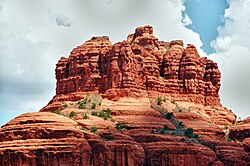Earth:Schnebly Hill Formation
From HandWiki
Short description: Dark red sandstone, the major component of the red rocks of Sedona, Arizona
| Schnebly Hill Formation Stratigraphic range: 286–273 Ma [1] | |
|---|---|
 Bell Rock, Sedona | |
| Thickness | 800 feet (240 m) to 1,000 feet (300 m) |
| Lithology | |
| Primary | Sandstone |
| Location | |
| Region | Colorado Plateau |
| Country | United States |
| Type section | |
| Named for | Sedona Schnebly |
| Location | Arizona |
| Thickness at type section | 800 feet (240 m) to 1,000 feet (300 m) |
The Schnebly Hill Formation is a section of red bed deposits found at the Colorado Plateau, near Sedona, Arizona. It is a dark red sandstone, from 800 feet (240 m) to 1,000 feet (300 m) thick. It lies between Coconino Sandstone and the older Hermit Formation.[2] It is near the Supai Group.[3]
The source of the name "Schnebly" is Sedona Schnebly, after whom the city of Sedona, Arizona, was named.[4]
Geology
The formation traces to the Permian Age.[5][6]
The formation is the most prominent layer of the red rocks of the Sedona area due the presence of hematite – iron-oxide, frankly, rust – giving the sandstone a red color. The Schnebly Hill Sandstone formation comprises three sections:
- the Bell Rock member,
- the Fort Apache member, and
- the Sycamore Pass member.[7]
See also
Sedona-area rocks
- Bell Rock
- Capitol Butte
- Cathedral Rock
- Courthouse Butte
- Red Rock State Park
- Slide Rock State Park
Local geology
Local interest
- Cottonwood, Arizona
- Honanki
- Jerome, Arizona
- Jerome State Historic Park
- Chapel of the Holy Cross
- Oak Creek Canyon
- Palatki Heritage Site
- Slide Rock State Park
References
- ↑ "Geologic Unit: Haskell". National Geologic Database. United States Geological Survey. https://ngmdb.usgs.gov/Geolex/Units/SchneblyHill_10001.html. "early Permian (Leonardian)"
- ↑ Cook, Terri (November 20, 2015). "Travels in Geology: Sedona: A journey to the edge of a supercontinent". https://www.earthmagazine.org/article/travels-geology-sedona-journey-edge-supercontinent/.
- ↑ Blakey, Ronald C.. "Central Arizona". http://repository.azgs.az.gov/sites/default/files/dlio/files/nid1646/sp-5_central_arizona_p142-196.pdf.
- ↑ "History of Sedona". https://www.sedonaaz.gov/home/showdocument?id=34040.
- ↑ Waverly, Lowell (January 9, 2017). "Chapel in the Rocks". https://archives.ced.berkeley.edu/blog/chapel-in-the-rocks.
- ↑ Bills, Donald J. "USGS Scientific Investigations Report 2005-5222, plate 1". https://pubs.usgs.gov/sir/2005/5222/sir2005-5222_plate1.pdf.
- ↑ Voges, Brianna. "Sedona Red Rock Formation". https://sedonaformation.weebly.com/schnebly-hill-sandstone-formation.html.
External links and references
- Schnebly Hill Formation, a few images
- A hiking site on the Schnebly Hill Formation
- Travels in goeology, Sedona area
- How were Sedona's red rocks formed?
- Relationship between Schnebly Hill Formation and the Supai Group
- On YouTube video
 |

